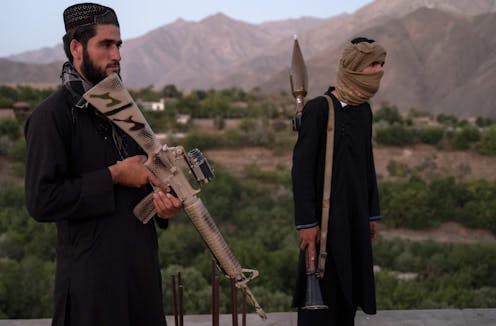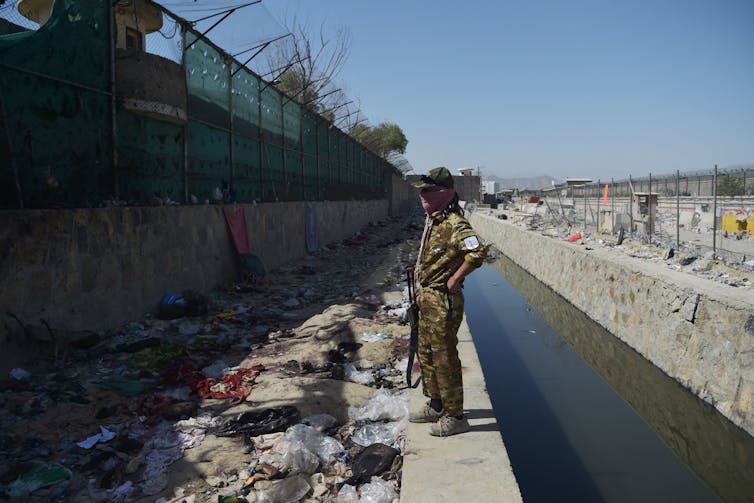
When the Taliban returned to power in Afghanistan on Aug. 15, 2021, there were faint hopes that this time would be different.
The Taliban promised to respect girls’ education and women’s rights, and to not allow the country to become a breeding ground for terrorism, as it had been in the Taliban’s previous stint in government before the 2001 U.S. intervention.
But a year after the fall of Kabul, the Taliban has failed to deliver on these promises and gradually become more repressive as it tries to consolidate power in the country.
Its record on women’s rights has been abysmal, as has its distribution of much-needed humanitarian aid.
Meanwhile, the view that the Taliban could meaningfully mitigate the counterterrorism concerns of the West has only grown more absurd since it first made such promises as part of 2020’s Doha agreement to secure a U.S. exit. The Taliban’s leading political ranks remain dominated by wanted terrorists, including members of the influential terrorist group the Haqqani Network.
As scholars who monitor extremist groups in the region, we believe terrorists in Afghanistan have only become more emboldened in the first year of Taliban rule. And despite isolated successful operations by the U.S., including the recent drone strike that killed al-Qaida chief Ayman al-Zawahri, we are still concerned that U.S.‘s current counterterrorism policies are insufficient to contain the growing threat.
False promises
Taliban statements both before they took power and after suggested that the group – publicly, at least – was shunning terrorist groups and foreign fighters.
But the most recent United Nations security monitoring reports warned that the Taliban are simply relocating some terrorist groups and individuals to make them more inconspicuous. Moreover, the Taliban are allowing the continued functioning of terrorist training camps, and potentially even awarding citizenship to some foreign fighters, the monitoring team reported in May 2022. Their assessments suggests that al-Qaida “has a safe haven under the Taliban” while casting doubt over the Taliban’s intent to restrain other terrorist groups, including ISIS-K, an offshoot of the Islamic State group.
The Taliban’s disdain for its Doha commitment not to allow “individuals or groups, including al-Qaida, to use the soil of Afghanistan to threaten the security of the United States and its allies” was exposed most recently in the case of al-Zawahri. Prior to the terrorist leader’s death, al-Zawahri was residing in downtown Kabul apparently under the permission, invitation and protection of top Taliban officials.
The accommodation of al-Qaida is not isolated. The Taliban has similarly been reluctant to crack down on the Tehrik–e-Taliban Pakistan, the Afghan Taliban’s deadly terrorist ally in Pakistan that has increased cross-border attacks on Pakistan following the U.S. withdrawal from neighboring Afghanistan.
Sheltering terrorists
The circumstances of al-Zawahri’s death have left many unknowns. It is not clear who among the Taliban was aware of al-Zawahiri’s presence – the group’s initial statement on the U.S. strike suggested that it had “no knowledge of his arrival and residence.” Nor is it immediately apparent how the targeted killing will affect intra-Taliban dynamics, including for younger and more hard-line members who may push senior leadership to respond aggressively.

Counterterrorism experts have also voiced concerns over which other al-Qaida members the Taliban might be sheltering.
What is apparent is that at least some high-ranking Taliban felt comfortable enough, despite public commitments, to host a terrorist leader who continued to incite violence against the West until his death.
The repercussions of this decision could further hamper the stability and well-being of Afghanistan. If the Taliban continue to fail on their commitments to steer clear of harboring militants, the country is likely to remain an international pariah, which will only worsen its rampant problems and potentially steer Afghanistan toward another civil war.
Resistance to Taliban rule
Despite their seemingly rapid takeover of the country in August 2021, the Taliban have yet to exert full control over all of Afghanistan.
In addition to the severe economic crisis, pockets of resistance persist, and in some areas appear to be growing. Reports suggest that by spring 2022, the number of armed groups challenging the Taliban’s authority had grown significantly. Among them is a breakaway Taliban faction led by an ethnic Hazara commander named Mawlawi Mehdi and the National Resistance Front led by the son of Ahmad Shah Mahsud, the deceased former leader of the anti-Taliban Northern Alliance.
The Taliban have since deployed tens of thousands of their fighters to suppress both groups.
What’s more, in May 2022, dozens of exiled warlords who fled the country rallied together to form the High Council of National Resistance. The leaders of the council are demanding a stake in their country’s future or else, in the words of the Uzbek warlord Abdul Rashid Dostum, “Afghanistan will experience civil war once again.”
And then there is the challenge posed by ISIS-K. We warned back in February 2021 and again in October that American drones and the Taliban’s animosity for ISIS-K wouldn’t be enough to stop the group’s revival and violence. Indeed, in January 2022, we traced ISIS-K’s resurgence under its new leader, from its depletion following years of personnel and territorial losses due to military operations, to the revived threat that the group poses today. The deadly consequences of that resurgence were seen on Aug. 26, 2021, in an attack that left at least 100 people dead, including 13 U.S. troops.

At present, ISIS-K is in the middle of two key campaigns. The first is aimed at building a wide militant base that draws on local populations and regional militant groups. The second is a campaign to delegitimize the Taliban through attacks and propaganda designed to highlight Taliban incompetence, and frame the Taliban government as illegitimate.
Over time – and with the backing of the core Islamic State group in Iraq and Syria and other resistance groups draining the Taliban’s resources – we believe ISIS-K has the potential to chip away at the Taliban’s governance while expanding its own influence.
A global threat?
Emboldened militant groups in Afghanistan pose a threat not just to the country itself, but also to the region and potentially the global community.
The Taliban’s success in retaking Afghanistan encouraged an already-resurgent Pakistani Taliban to pursue a campaign of violence and push for political concessions from the Pakistani government.
Similarly, al-Qaida’s global network of affiliates has drawn inspiration from the Taliban’s victory. And despite the symbolic blow of al-Zawahri’s death, many of those affiliates in the Middle East and Africa remain operationally unaffected by any fallout from the U.S. strike.
In spite of the success of that operation, debate continues over the effectiveness of the United States’ over-the-horizon counterterrorism strategy, which involves the launching of surgical strikes and special operations raids from outside the country.
The al-Zawahri operation demonstrated that sound intelligence can result in effective targeting of high-profile terrorists. But counterterrorism experts including ourselves remain concerned over whether such strikes can be effective in targeting less prominent militants who nevertheless play a critical role in the day-to-day operations.
To bolster the strategy, the U.S. could seek out more robust relationships with resistance groups hostile to the Taliban, as well as with neighboring Central Asian countries, such as Tajikistan and Uzbekistan, in order to bolster the intelligence needed to conduct over-the-horizon strikes. But such partnerships would not come without their downsides, including further isolating the Taliban.
International diplomatic efforts and U.S. counterterrorism operations, along with internal pressure from resistance groups and jihadist rivalries, may encourage the Taliban to reform its ways.
But if the second year of Taliban rule fails to produce meaningful changes, the outlook for the country and its citizens will likely only turn for the worse.
The authors do not work for, consult, own shares in or receive funding from any company or organization that would benefit from this article, and have disclosed no relevant affiliations beyond their academic appointment.
This article was originally published on The Conversation. Read the original article.







